With lasting expected effects on consumption, business models and marketing expenditure, Covid-19 and the lockdowns that followed have impacted supply, demand, and media consumption for businesses across several industries.
Profit spoke to several leaders across apparel, consumer packaged goods (CPG), food & beverages (F&B), and online marketplaces to understand how businesses decided to adapt to the ‘new normal’ that has interrupted value chains and ecosystems. Over the next few weeks, we will be examining what that ‘new normal’ looks like across each of these industries.
This article concerns the six apparel companies in Pakistan, three of which design, manufacture, market, and sell local brands while the other three import, market, and sell international brands – with both types of companies operating a retail presence as well as an online presence. Our reporting here includes surveys and interviews we have conducted with key people at these companies, or people who are familiar with the operations of these companies.
What we have found are three key trends across the sector as a whole that help illuminate the brave new world companies in this sector find themselves operating in.
Key Findings
- Same-store sales at brick-and-mortar outlets tanked
The attached bar chart shows that e-commerce revenue as a percentage of overall sales has either doubled or tripled for most of the companies surveyed. This does not necessarily mean that absolute revenue of these companies has also increased, only that shopping behavior has changed.
All anonymous respondents shared that projected revenue targets for the first and second quarters of 2020 were missed by up to 75%. This means that same-store sales revenue have gone down overall, even in absolute numbers, according to all respondents.
Behavior shifted out of necessity, not due to the user experience
When buyers have the option between shopping at a store and shopping online, while choosing the latter, historically, that has been by choice. The lockdown and the fear of contracting the virus has meant that urban buyers have no other option except for e-commerce – be it with owned brand stores, marketplaces, or pure players.
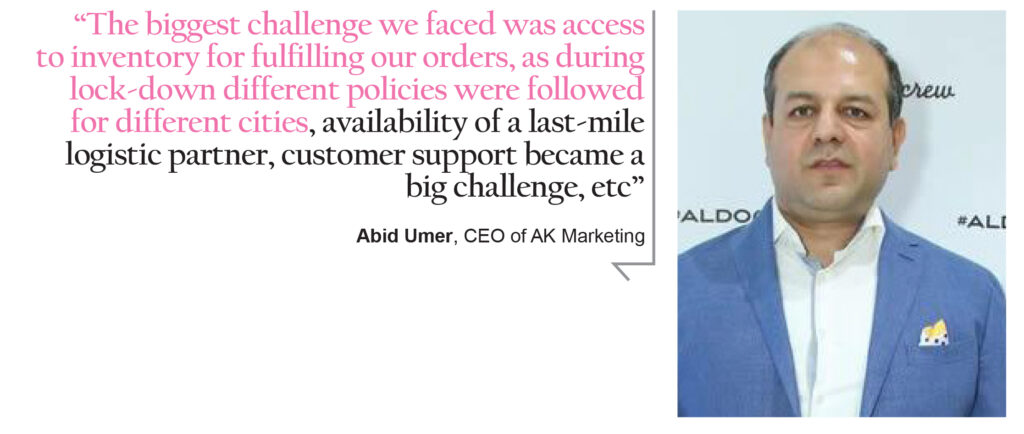
Profit’s survey data shows that shoppers substituted in-store purchases with online purchases. Based on the layoffs across the apparel and fashion industry and the austerity measures being taken in outsourcing key business units, it can be inferred the overall market has shrunk and that average basket size as a whole is less, thus making the share of e-commerce seem higher. For Albaraka Apparel, for instance, the decline in retail sales was almost exactly equaled by the growth in e-commerce sales.
Discounting everywhere
Respondents shared that savings on store rentals allowed many companies to offer deep discounts, even across premium categories. From AK Galleria to Junaid Jamshed, every clothing retailer surveyed slashed prices to achieve a semblance of sustainability – with discounts of up to 50% – during the first three months of the Covid-19 lockdown and curfews.
This decision, which commoditised various brands – seen by some observers as potentially depreciating brand equity and brand-building efforts – was also a factor for organic e-commerce growth, not just a desire to use the alternative revenue source. Compounded with the challenges faced by retailers since the pandemic, year on year revenue has declined to date and thus overall profitability has been impacted.
CASE STUDIES
To analyse the impact of the pandemic on the industry, Profit examined six companies, three of which sell local brands, and three of which sell foreign brands. All of them have both an e-commerce presence and physical retail outlets as well. We selected a diverse sampling to get a better understanding of the trends shaping the industry.
Tudors Pakistan
Operating out of 21 countries and 500 stores, in 2017 Tudors opened its first stores in Pakistan, starting with LuckyOne Mall in Karachi. Today, the Turkish-owned fast fashion men’s shirts and accessories retailer operates four stores nationwide and an online store. Led by Haris Ahmed, CEO of Tudors Pakistan, the business has mostly relied on sales coming from its brick-and-mortar outlets.
Speaking to Profit, Ahmed said that the online presence supports the overall sales ecosystem with an 8% to 10% contribution to the company’s revenue. He said that same-store sales is down by 74% while the online business is up by 142% for Tudors Pakistan.
“With the Covid-19 lockdown, the offline business has taken a nosedive,” said Ahmed. “Within the first two weeks of the lockdown, we realised that this could be a good opportunity to expose all inventory present in stores onto the website to maximize product offering and deepen product availability. This worked well for us since online was a growing [source of revenue] for us and our existing customer base couldn’t access physical points-of-sale to buy products. We spent more on advertising and promotion, targeting a younger set of customers via accessories and fragrances, which clearly opened up a newer market segment with lower price points and reflected a higher order volume.”
Tudors Pakistan ran an ad campaign three weeks before Eid, which Ahmed claimed made a big difference to online sales. Using micro and nano influencers, he said that Tudors Pakistan offered dedicated offer codes from social media to push new products to a wider customer segment which meant that website browsing sessions were converted into transactions.
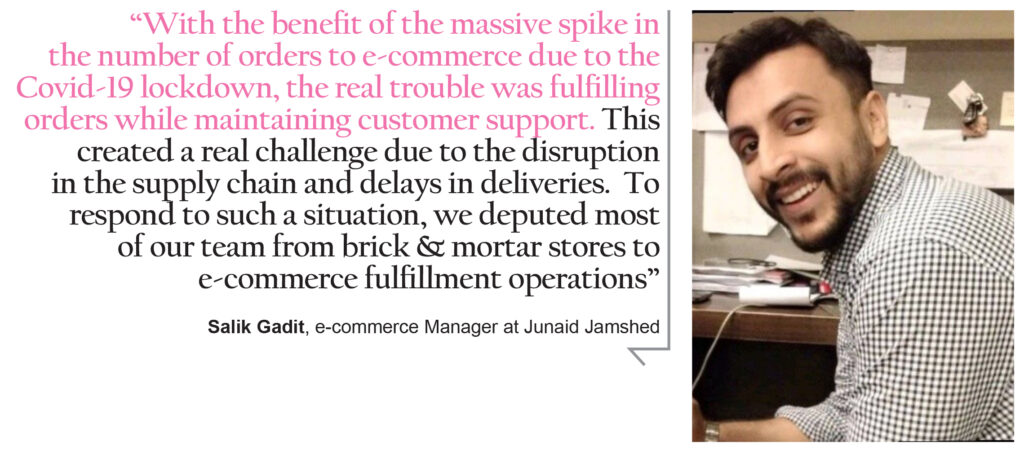
This decision reportedly resulted in a 60% increase of organic traffic on the Tudors Pakistan website and a 70% higher conversion rate (meaning customers who actually bought something), demonstrating promising growth.
“Through online sales, we almost surpassed revenue of one of our stores in Lahore, contributing to a good 23% of the total, in case all stores were operational as well,” he said. “With looming uncertainty in consumer-driven markets, it is difficult to predict any overall growth going into the third and fourth quarters of 2020. However, we see an opportunity for tremendous growth in online sales. We feel we can reach new customer segments in the next six months through our products.”
Ahmed anticipates that in 2020, between 35% and 40% of all revenue for Tudors in Pakistan will come from e-commerce, with major challenges being around scale, particularly related to real estate. Ahmed told Profit that rental overheads are a major portion of the cost of sales unlike many other industries present.
And with commercial property prices in Pakistan as high as many US and European cities and consumer spending power as low as that of Bangladesh, Nigeria, and Indonesia, Ahmed sees a major imbalance problem. He said that scaling offline is a capital intensive, high-risk, and a slow responding move, but in a market like Pakistan, it might be the only way for fashion retailers for at least the next decade.
“Our category offering isn’t as wide as some of the other menswear brands in the business so we see almost a flat-line when it comes to revenue contribution category-wise on a month-on-month basis,” he said. “Nevertheless, we have seen higher customer interest in the “FIT” rather than the print, pattern, texture or color. This is an extremely promising indicator for us as we specialize in fits and offer more than 5 fits across all categories of men shirting. Recently we have seen a higher peak in sales for fragrances and accessories and we expect higher growth numbers in these categories as we go towards closing 2020.
On the downside, Ahmed noted a drop in demand for value-added products such as stainless, wrinkle-resistant, and ply yarn shirts as they are pricier and might not be an easy purchase online, without understanding fabric qualities and dynamics. He is nevertheless certain that prices will again play a vital role in determining sales and contends that as Pakistan goes deeper into the lockdown he might see promotions and discounts as major catalysts towards meeting sales expectations.
Team A Ventures
Just last year, Team A Ventures – a company that owns Pakistani franchise rights to several foreign apparel brands – took a leap of faith with relatively large-scale investments in setting up e-commerce sites for virtually all the international brands it represents in Pakistan as the master franchisee. This includes Mothercare, NEXT, Early Learning Centre, Superfeet, Crocs, Timberland, Havaianas, Accessorize, Monsoon Children, and FitFlop.
Synite Digital, a digital agency in Pakistan affiliated with Dentsu (a large, global advertising and public relations company headquartered in Tokyo), secured the digital remit based on a performance marketing plan devised by Tariq Hameed Siddiqui, brand head for the digital business unit at Team A Ventures. In 2019, e-commerce generated 5.8% of the total revenue for Team A Ventures.
Siddiqui told Profit that the Covid-19 lockdown led Team A Ventures to shutter two of its 13 stores, with resources being directed to route inventory across Karachi, Lahore, Islamabad, Rawalpindi, Multan, and Gujranwala to its online store.
The near-overnight transition to e-commerce was marred with challenges. It all boiled down to analysis paralysis, the choking of courier infrastructure, hurdles in inventory movement, rising lead times to customer deliveries, and capacity issues. Siddiqui said that there were instances when the stock was packed and it would take up to four days for stores to handover the inventory to the courier partner.
“Since the inventory was so scattered throughout, the biggest challenge was orders that had more than one store origin. According to our calculations, 47.5% of total orders received had two or more inventory origins,” he said.
“Although we did train the store staff virtually on how to prepare orders, almost half (48%) of all ordered store stock had to be sent back to our central warehouse in Karachi to prepare. The entire courier infrastructure, although barely functional, was choked. Shipments meant for overnight delivery were taking five to six days. Some even took more than a week.”
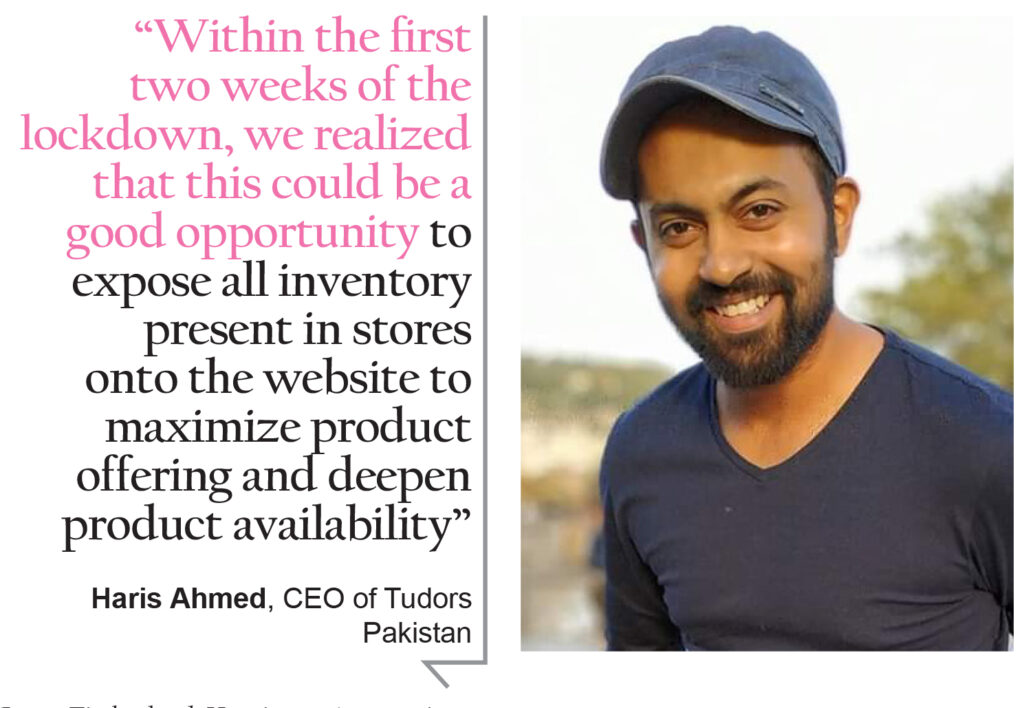
When stores were abruptly opened as the lockdown and curfew eased for Ramazan and Eid, resources fixated on packing orders had to be diverted to prepare for store openings. The packaged items were instead sent to a warehouse, which caused further delays. Siddiqui shared that shorter work timings during Ramazan meant that same city deliveries often took three to four days longer, impacting the customer experience against benchmarks in lead times.
“As a result of all these challenges, irate customers created a bash galore across our touchpoints, especially on social media,” he said. “When you’re tasked to ship more orders in a single month compared to what you did the whole last year, capacity issues were bound to come and they did. Since a lot of stores after Eid had lower footfalls, we called in the store staff at the warehouse to help with the order delivery. Our May 2020 e-commerce sales alone saw us do 156% of total e-commerce revenue for 2019.”
Quoting the latest insight report from Google, Siddiqui said that Pakistani netizens have soared during this lockdown, taking the tally to almost 78 million, with the forced behavior change bringing about positive boosts for e-commerce business nationwide.
He foresees that 2020 e-commerce revenue for Team A Ventures will be between 25% and 30% of total revenue, up from 5.8% in 2019. The top product categories contributing to sales were newborn clothing, kids fashion, and hardware, which went from contributing to 11% to 17.6% of total sales. He added that shoes have seen a decline, resulting in the company having to spend more advertising rupees to achieve the same level of sales. The cost per customer acquisition has soared by almost 67%.
“Stores may have opened but the Covid-19 scare still has people shopping safely at home. It is also evident from the low footfall in stores, excluding the four to five days before Eid, when it was a frenzy,” he said. “Plus, the economy isn’t looking very bright either, in fact, I foresee that a lot of market focus will be on promotional sales throughout 2020 in a bid to sustain revenue.”
He rejoiced that omnichannel sales strategy – an approach to sales that allows a company to to provide customers with the convenience of choosing the device or format through which they shop – has graduated from a buzzword to ground reality, with logistic accuracy and a robust tech stack being paramount more than ever.
The highest levels of service, though at times challenging, will be key in a post-pandemic world, where even modern retail needs to evolve to cater to e-commerce paths to generate revenue. Moving forward, Siddiqui said that outlets will be required to be e-commerce ready to survive, so much so that they might even be built in a way to cut lead times for inventory movements and order processing. That said, he was also of the opinion that last-mile delivery operators will also see a boom.
That surge in demand online has meant that the company has been able to see a dramatic uptick in the effectiveness of its online marketing efforts.
“In our case, we have seen a surge in conversion rates across almost all platforms,” he said. “What stood out were YouTube Preroll, Facebook Catalog Ads, Instagram Stories, Dynamic Search Ads, and SMS. Also, conversion from referral sources and sites this time around saw a huge jump – the highest I’ve seen in my career yet.”
AK Marketing
Similar to Team A Ventures, AK Marketing is the Pakistan franchisee, retailer, and distributor for a range of international brands. Operating 30 stores nationwide for Mango, Splash, Babyshop, Women’s Secret, Aldo, and Meme, the company generated 90% of its total sales in 2019 from brick and mortar locations, while the remaining 10% came from AK Galleria, an online store that aggregates the brands it sells along with some of those of companies that are not direct competitors.
Following the declaration in late January from the World Health Organization (WHO) that Covid-19 was a Public Health Emergency of International Concern, AK Marketing took measures to upgrade its standard operating procedures (SOPs) for the safety of its staff and customers. By the time the WHO declared the outbreak a pandemic in March, AK Marketing was in talks with complementing brands to join the AK Galleria marketplace.

“The biggest challenge we faced was access to inventory for fulfilling our orders, as during the lockdown, different policies were followed for different cities. The availability of a last-mile logistics partner and customer support became a big challenge,” said Abid Umer, CEO of AK Marketing. “We reacted quickly by allocating our retail team to ensure the smooth running of our e-commerce channel, but the number of orders was far greater than what we could handle at the time. We are now updating our whole infrastructure to harness the new levels of demand.”
Umer shared his confidence that the shoppers in Pakistan trust e-commerce websites from a discovery and consideration standpoint, with growing evidence suggesting conversions are on the rise. He believes that – all else being equal – by the end of 2020, the e-commerce sources of revenue will have generated half of the total revenue for AK Marketing, which was only 10% the year prior.
He credits this with the positioning of AK Galleria being targeted at a segmentation that values premium products from international markets. He added that same-store sales for retail outlets are down 50% while revenue is up 40% for e-commerce – with overall revenue down 35% year on year.
Similar to the challenges listed above for Team A Ventures, Junaid Jamshed, and Tudors, AK Marketing struggled to adapt quickly, with the need to update the supply chain, platform, and customer relationship management tools. He credits social media as being the primary advertising medium driving conversion to the online site, adding that a strong existing database of loyal buyers has contributed the most to targeting.
“The formal wear category remains challenged as people stay at home,” he said. “The new term of stay-at-home and WFH (work from home) categories are now being measured where customers have updated their wardrobes with more casual clothing, and shoes/sandals. Another area of growth is personal care, including lifestyle improving and sports category.”
Junaid Jamshed
With over 70 outlets all over Pakistan bringing in nearly 95% of its revenue, the closure of brick and mortar locations meant that Junaid Jamshed had a lot to lose. The lockdown meant that a digital transformation initiative, which would have taken a year to execute in normal circumstances, had to be accelerated to three months to avoid business failure.
Based on the current trajectory, the company foresees that 30% of 2020 revenue will come from e-commerce, with most of the current quality customer acquisition attributed to organic traffic. Salik Gadit, e-commerce Manager at Junaid Jamshed, told Profit that, so far this year, revenue on e-commerce has grown by four times compared to the same period in 2019.
“With the benefit of the massive spike in the number of orders to e-commerce due to the Covid-19 lockdown, the real trouble was fulfilling orders while maintaining customer support,” said Gadit. “This created a real challenge due to the disruption in the supply chain and delays in deliveries. To respond to such a situation, we deputed most of our team from brick and mortar stores to e-commerce fulfillment operations.”
Salik Gadit told Profit that his team tested with a ship-from-store strategy to fulfill online orders, though this was troublesome due to the lack of knowledge at the store level and the absence of a highly integrated omni-channel system. The failure helped him build the case to implement an omnichannel strategy in the future and the desire to maintain social distancing has meant he operates with half his warehouse teams while attempting to fulfill orders from customers used to quick deliveries.

“The biggest challenge right now is customer retention which mainly is being affected due to operational bottlenecks [such as] courier performance, customer support, the fulfillment of orders on time, etc along with maintaining safety and health concerns of our team,” he said. “Our challenges change with the change of government policies and orders, yet again considering the increased tense situation due to Covid-19. The current situation has already made customer acquisition easy, now the real challenge is customer retention.”
Albaraka Apparel
Holding the Pakistan franchise of brands such as French Emporio, Diners Milano, Sohaye, and Diners, Albaraka Apparel responded just like everyone did to the Covid-19 lockdown and curfews – with deep discounting and ramping up e-commerce.
With 95 outlets in 31 cities closed, the apparel business went from selling 5% of sales volumes in 2019 from e-commerce to selling 25% of sales volumes in 2020 – based on existing numbers and projections – while year on year nominal revenue has declined due to discounting and an overall slump in volumes.
“Since from 18th of March, Pakistan faced lockdowns during Pakistan Day sales, the consumer shift was seen toward e-commerce – we immediately moved our stocks from stores to e-commerce and increased the e-store inventory threefold,” said Humair Saleem, brand manager at Albaraka Apparel. “Also the resources of brick and mortar stores were moved to the e-commerce department.”
With the business reacting similarly to its competitors, Albaraka Apparel sought to shift its organogram to focus around e-commerce. Cross-functional teams were created to house sales, operations, customer support, supply chain, and operations under one digital business unit. Similar to competitors, Albaraka Apparel struggled with order fulfillment, inventory management, shelving, and customer support.

“Marketing budgets were shifted to e-commerce so the sales were increased enormously on digital,” said Haleem. “A team was also dedicated to ensuring SOP’s which were given by WHO, like regular disinfectant sprays on order, wearing gloves masks and ensuring usage of sanitizers in warehouses and in operations. It had become a war zone. e-commerce [contribution percentages] witnessed a growth of around ten times in April and May if we compare it with 2019. From the current scenario, we can see around 15 to 20% growth from last year”.
He credits social media, entertainment websites, cable network partnerships, and SMS marketing for driving traffic that converts on the online store. Similar to other respondents, most of the revenue came from organic traffic as loyal shoppers were unable to access retail locations.
“The women’s clothing category has seen a decline in our case because of non-availability of too much stock as we sold most of our designs and stock during our Pakistan Day sale,” said Haleem. “After that, [a] pause in production played its negative part. Growth had been seen based on needs and events, like in Ramazan shalwar kameez, kurta and waistcoats were [the] highlight along with kids category be it ethnic or western. Just after Ramazan and Eid when some of the offices started opening shirts and trousers are experiencing growth.”
Al Rahim Textiles Industries
A year ago, Al Rahim Textiles Industries made the decision to cannibalise its cash cow and redirect resources towards its star product. May 2019 was the last time Kapray products were available nationwide, replaced entirely by a focus towards Zellbury.
With 33 active stores across 20 cities, Al Rahim Textiles Industries sought to kill two birds with one stone by making the transition early on to use physical outlets as both a point of sale and being fulfillment centers for e-commerce customers. The strategy, which also mimics the function of Daraz Stores, was a key challenge for nearly all respondents to this Profit survey.
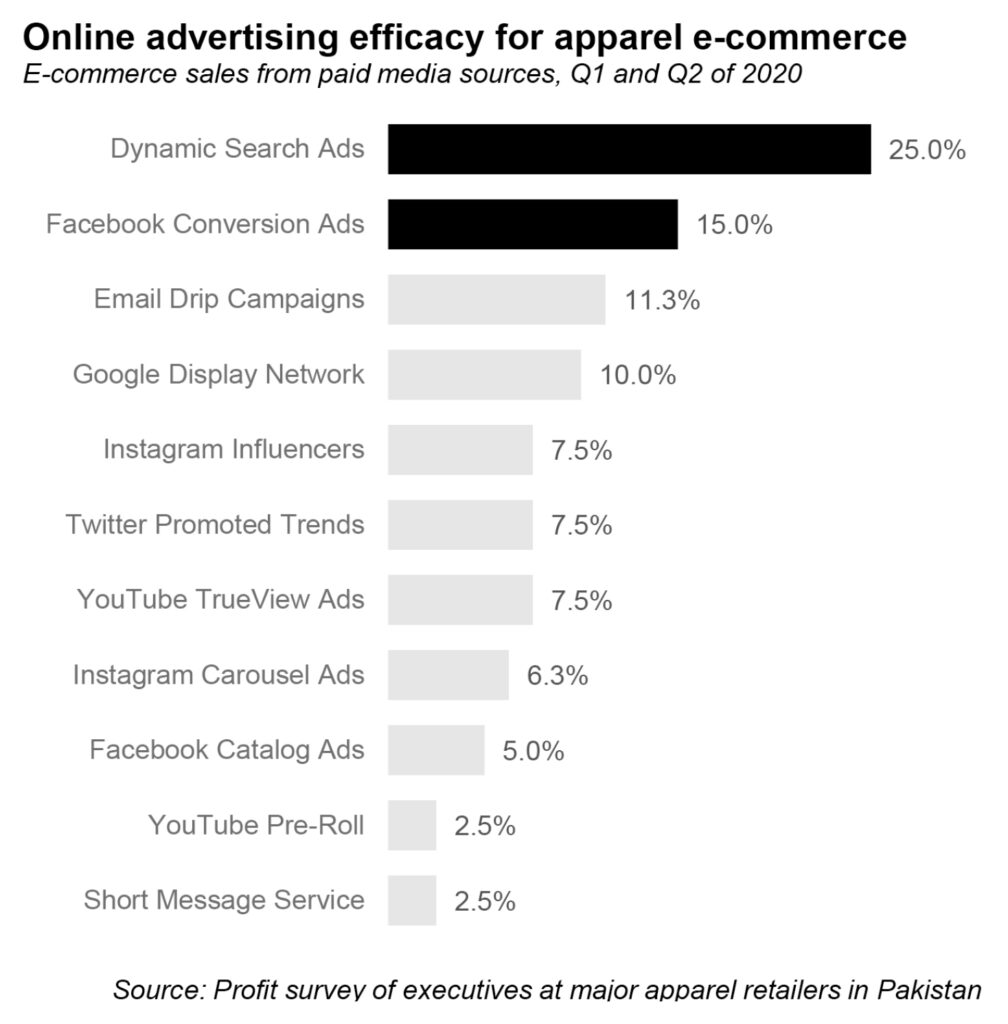
“Since the start of this fiscal year we have been increasing our resources for e-commerce growth,” said Hammad Illyas, head of marketing at Al Rahim Textiles Industries. “This included efforts in enhancing online shopping experience for the customers, increasing fulfilment capacity and automating our processes to cater to growing demand and faster deliveries for our e-commerce orders. With increased focus on the online revenue source we have seen an exponential growth in our share in sales of e-commerce. The share that was at 5.8% in 2019 is projected to jump over 25% by the end of 2020. Currently we’re already at 20%”
Illyas told Profit that the top organic customer acquisition sources were search (primarily Google), Facebook, Instagram, and direct traffic, while the top paid customer acquisition sources were paid Search, Facebook, and Instagram.
“Human resource training is the biggest challenge ahead,” said Illyas. “We’re looking at over 400 people [to be] all trained to fulfil e-commerce orders. Courier readiness in-terms of APIs and integration can be the next challenge in delivering the best optimized experience.”
Syed Waqas Pervaiz, head of e-commerce at Al Rahim Textiles Industries, told Profit that the pandemic presented some positives in online growth, including a flourishing contribution margin and the validation of an omnichannel fulfillment strategy.
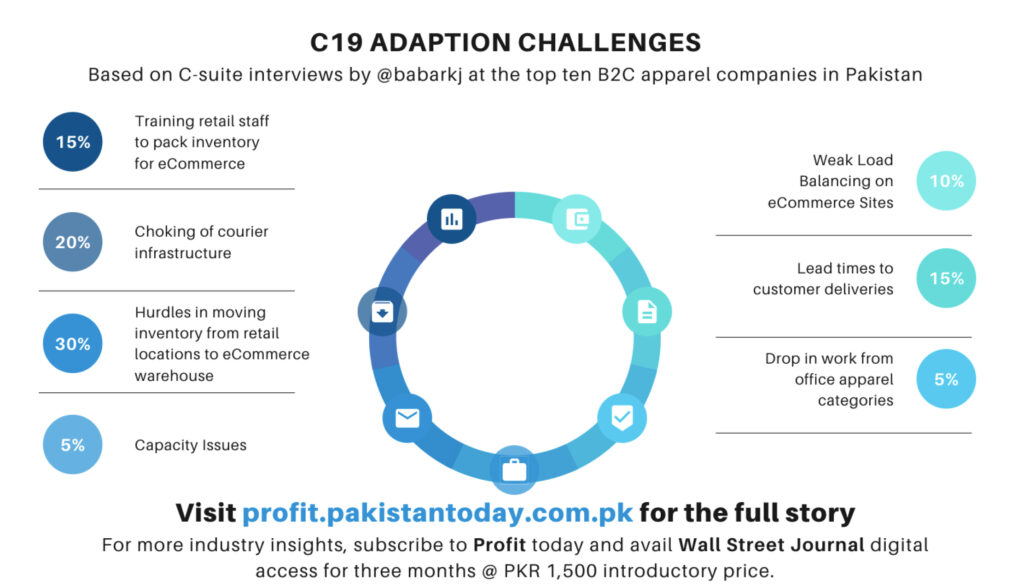
“As per our estimation, e-commerce will be delivering 25% of our overall sales number while selling 99% of sales without any discount,” said Pervaiz. “Kapray was a more conventional brand with the conventional business model based on discounts, while Zellbury has a, what we believe, a more forward looking approach. This is thanks to our ‘Real Fashion, Real Prices’ strategy with which we have reduced our pricing and let go of season sale events. “
Illyas told Profit that a sales strategy centered around discounts is unsustainable, because it leads to price skimming over time, thereby commoditising and undercutting brand building investments. He added that a men’s designer brand is currently at a flat 80% sale, so if Al Rahim Textiles Industries competes in the same rat race, there is no end to it.
Unlike the other five respondents to this survey by the Profit, all of whom offered deep discounting in order to clear stocks and reach sustainability, both Pervaiz and Illyas of Al Rahim Textiles Industries insist that only 1% of the Zellbury products sold during 2020 were discounted with the remainder sold at full price. Both respondents said this is part of a new strategy to avoid discounts.
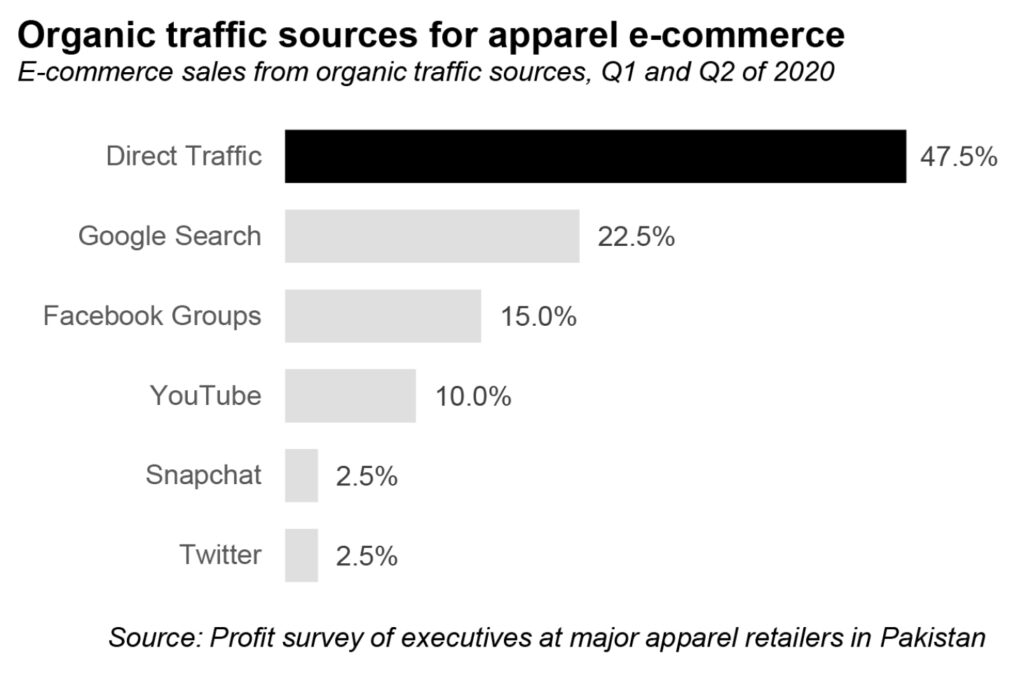
While the absence of discounting to achieve sales targets is a testament to successful brand equity development, it should be noted that from a pricing standpoint Zellbury’s full price – without discounts – is between 30% to 50% lower than the discounted prices of its category competitors such as Bonanza, SanaSafinaz, Sapphire, and Gul Ahmed. In this way, the business is indirectly competing on pricing, which was part of its 2020 relaunch campaign, which communicated penetration pricing.
Additional data analysis: Ariba Shahid





































The markets are changing and everyone is now looking to take a pie out of online sellers markets. We have seen new facebook buy and sell groups for peer to peer selling and they seem to be increasing on a daily basis. Limitations are still there, the COD companies have really picked up, we are still waiting for mobile money transformation, but that wont happen until we see trust between buyers and sellers.
Thoroughly researched article! Looking forward to seeing more well researched articles like this!
This period of pandamic changed many things and heavily effected on shopping. One of the responses we’ve seen to how people are approaching this period of isolation and uncertainty is in huge overnight changes to their shopping behaviors. From bulk-buying to online shopping, people are changing what they’re buying.
After the Covid-19 cases arisen in Pakistan, The businesses has now started knowing the value of ecommerce. Customers who used to visit stores are welcoming this new-normal thing to do online shopping at home while saving their time as well.